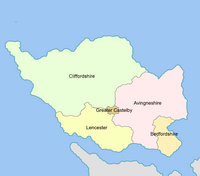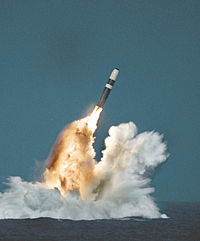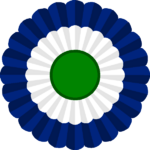Albeinland: Difference between revisions
m (→Military) |
|||
| Line 133: | Line 133: | ||
===Military=== | ===Military=== | ||
{{main|Albish Armed Forces}} | {{main|Albish Armed Forces}} | ||
[[File:Trident_II_missile_image.jpg|thumb|left|200px| | [[File:Trident_II_missile_image.jpg|thumb|left|200px|A [[Albish Army|XP-2 guided missile]].]] | ||
[[File:Royal_Air_Force_Eurofighter_EF-2000_Typhoon_F2_Lofting-1.jpg|thumb|right|200px|generic plane name here]] | [[File:Royal_Air_Force_Eurofighter_EF-2000_Typhoon_F2_Lofting-1.jpg|thumb|right|200px|generic plane name here]] | ||
[[File:HMS_Queen_Elizabeth_(R08)_underway_during_trials_with_HMS_Sutherland_(F81)_and_HMS_Iron_Duke_(F234)_on_28_June_2017_(45162784).jpg|thumb|right|200px|An [[Albish Navy|Albish Navy]] task force in the Agric Ocean.]] | [[File:HMS_Queen_Elizabeth_(R08)_underway_during_trials_with_HMS_Sutherland_(F81)_and_HMS_Iron_Duke_(F234)_on_28_June_2017_(45162784).jpg|thumb|right|200px|An [[Albish Navy|Albish Navy]] task force in the Agric Ocean.]] | ||
The [[Albish Armed Forces]] is one of the oldest institutions of Albeinland, established soon after its [[Magnanimous Revolution|unification]], and has as its {{wp|commander-in-chief}} the lord-protector, but is subordinated to the [[Cabinet of Albeinland|Secretary of Defence]] and its secretary. Currently, the armed forces is divided into three branches: the [[Albish Army|Army]], the [[Albish Navy|Navy]] and the [[Albish Air Force|Air Force]]. According to own military data, around 55,000 personnel, including active and reservist officers, make up the current Albish forces, one of the smallest of Beria. {{wp|Conscription}} was disbanded after the end of the [[Great War (Aurorum)|Great War]] in 1916. | |||
The Army is the smallest of all branches, being comprising only by a defence force due to Albeinland's small territory, numbers which have been decreasing since the end of the [[Melasian Crisis]]. Due to its size, Albeinland has prioritized more the use of {{wp|commando units}} rather than conventional forces and, since the late-20th century, a series of {{wp|Mechanization|mechanization programs}} have begun in order to make a more modernized military. | |||
The Navy is the biggest and most respected branch, with its origins coming from the [[Albish League]] in the middle ages. Thanks to Albeinland's colonial empire and trade activities, the navy always has the flagship of the armed forces, being one of the biggest in the world. In modern times, the navy is considered to be a {{wp|Blue-water navy|blue-water}} one, exercising military operations around the world with the help of other major powers. The majority of its ships are {{wp|destroyers}} and {{wp|corvettes}}, plus a substantial amount of {{wp|aircraft carriers}}. | |||
The air force is the most recent of all three branches, being created in 1919. It has about 350 manned aircraft in service, all of them in a relative state of modernization. | |||
Albeinland is one of the few nations of the world that possesses {{wp|nuclear weapons}} after a [[Operation Whitehorse|joint Albish-Mascyllary program]] in the 60s, resulting in the [[WH-1]]. With the ascension of {{wp|Terrorism|worldwide terrorism}}, the armed forces shifted its main focus to its {{wp|Counter-terrorism|combat}}, partnering with other countries, especially BDTA members, against terrorist groups. | |||
==Economy== | ==Economy== | ||
Revision as of 00:26, 4 September 2020
This article is incomplete because it is pending further input from participants, or it is a work-in-progress by one author. Please comment on this article's talk page to share your input, comments and questions. Note: To contribute to this article, you may need to seek help from the author(s) of this page. |
Commonwealth of Albeinland | |
|---|---|
| Motto: Domine, dirige nos (Cambran) "O Lord, direct us" | |
| Anthem: Battle Hymn of the Republic
| |
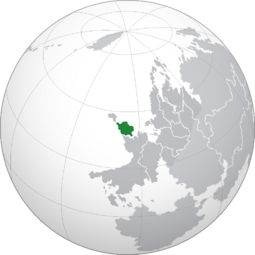 Albeinland (green) in Berea (grey) | |
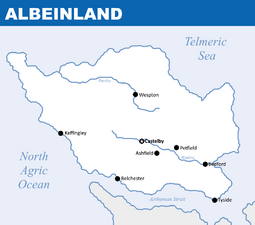 Political map of Albeinland | |
| Capital and largest city | |
| Ethnic groups (2020) | 87.9% White 7.2% Black 3.3% Pamiran 2.2% Mixed 0.1% Other |
| Religion (2020) | 88.2% Semitarism -74.9% Cambran sect -12.5% Nordic sect -0.8% Erytheian sect 7.3% Irreligious 4.1% Iqlad 0.4% Other |
| Demonym(s) | Albish |
| Government | Federal parliamentary republic |
| George Owen | |
| Vincent Lloyd | |
| Legislature | General Assembly |
| State Council | |
| House of Commons | |
| Establishment | |
| 10 May 1583 | |
| 13 November 1786 | |
• BDTA | 17 June 1944 |
| Area | |
• Total | 182,054 km2 (70,291 sq mi) |
• Water (%) | 0.6 |
| Population | |
• 2020 census | 6,472,318 |
• Density | 35.5/km2 (91.9/sq mi) |
| GDP (nominal) | 2020 estimate |
• Total | |
• Per capita | |
| Gini (2020) | low |
| HDI (2020) | very high |
| Currency | Sterling (ALB, £) |
| Time zone | UTC+1 (Albish Central Time) |
| Calling code | +16 |
| Internet TLD | .ab |
Albeinland, officially the Commonwealth of Albeinland, is an insular country located on the continent of Beria, sharing a maritime boundary with Sileria to the northwest and having a coastline on the Arthurean Strait to the south, the Telmeric Sea to the north and the North Agric Ocean to the southwest. With 6,472,318 inhabitants and 182,054 km² (70,291 sq mi), Albeinland is one of the smallest countries of the world.
The current Albish territory is populated since the Paleolithic era, with the first Foranic peoples migrating to the region in the 5th century BCE. The island would be annexed by the Cambran Empire years later in 85 CE, becoming an important trade hub due to its strategic location in northwestern Beria. After the fall of the empire, Albeinland would fracture itself into various petty kingdoms and tribes, leaving the area open for a series of intensive Cuthish immigrations in the 3rd and 4th centuries. The Cuthish population consolidated themselves as the new regional elite, with a series of merchant republics, market guilds and college towns being established. The fragility of these states led to the creation of the Albish League at the end of the 9th century, leading to total domination over trade routes in the Telmeric Sea and Agric Ocean.
After the Albish defeat at the First Cutho-Albish War in 1582, a series of nationalist movements overthrew the previous maritime republics and unified them into the Commonwealth of Albeinland. The Commonwealth saw the expansion of trade activities outside Beria with the creation of outposts in Pamira and Capthora, and established one of the first colonial empires of Aurorum. Internal disputes led to the end of the republic and the establishment of a monarchy in 1732, with the 18th century being known as a golden era as the country was at the centre of most philosophic and scientific discussions of the period. However, further political instability led to the Albish Spring in 1786, with a democratic republican government taking place.
The 1800s were marked by extensive colonial expansion and industrialization. Albeinland was one of the major combatants of the Great War, with its navy seeing action in every corner of the world. The end of the war led to the independence of former colonies, with decolonization happening gradually over the century. After the end of the Melasian Crisis, Albeinland was one of the founder-states, alongside Mascylla and Lavaria, of the Berean Defence Treaty Association, standing against the Mageiros League and the Perekovka Program in the Cold War. The country was severely hit in the general crisis of 1986, having been recovered since then.
Today, Albeinland is a developed country with a high-income economy, being regarded as one of the main colonial empires in history and having its language and culture present on every continent. Its capital and primate city is Castelby. The political framework is operated under a federal parliamentary republic with the Lord-Protector being the head of state while the Prime Minister is the head of government, and has as its national legislature the bicameral General Assembly, which has as its lower house the House of Commons and upper house the State Council. Given the nature of its political system, many specialists consider Albeinland to be a crowned republic. Currently, Albeinland is a member of the Assembly of Nations, the Berean Defence Treaty Association and the Albish-Silerian Council, among with other international organizations.
Etymology
History
Geography
Climate
Environment
Politics
Government
Albeinland is a federal parliamentary republic, with the Lord-Protector being the head of state while the Prime Minister is the head of government. The executive is composed by the lord-protector, the prime minister and the cabinet. The Albish political system is operated under the Common Charter, which is the semi-codified constitution that, alongside other documents, treaties and conventions, sets the directives of the executive, legislative and judiciary.
The lord-protector is the highest elected member of the commonwealth, being elected by the General Assembly after the death or resignation of the previous holder of the office, assuming the position for the entire lifetime. Despite being ceremonial, it's the responsibility of the lord-protector to convoke general elections after being asked by the prime minister, appoint or dismiss the government and represent the country on the world stage, among others. The lord-protector also is the commander-in-chief of the armed forces and is expected to act as non-partisan. Given its nature, many specialists see the office as the same of a monarch.
The prime minister is responsible for lead the cabinet, which has its members drawn from the parliament, in a primus inter pares system, generally being the leader of the party with the majority of seats in the Assembly. The prime minister needs parliamentary accountability to govern and must resign or declare new elections if such accountability is lost.
The General Assembly is the national bicameral legislature of Albeinland, having as the lower house the House of Commons and upper house the State Council. The House of Commons is the most important house of parliament, being composed by 209 MPs elected through a first-past-the-post system for a renewable term of five years, while the State Council is composed by 25 unelected members for an unlimited term of office to represent the regions on a federal scale.
As an electoral democracy, Albeinland has a strong two-party system, with the centre-right United Conservative Party (UPC) and centre-left Progressive Republican League (PRL) alternating power since 1921. Other parties that have minor representation in politics are the Liberal Democratic Union, Green Party, Reform Party and the Free Radical Group.
Administrative divisions
Albeinland has a complex and ancient system of national subdivisions that is dated from centuries ago. As a federal state, the country is subdivided into 5 regions: Avigneshire, Bedfordshire, Cliffordshire, Lencester and Greater Castelby, the last one only comprised by the capital city of Castelby, with each one having its executive, legislative and judiciary as established by law. The local government is headed by the first minister, which is elected in a similar way to the prime minister in the federal level, with the legislative being led by local authorities and the judiciary by regional courts. The second tier of administrative divisions is the counties, which are divided into metropolitan counties for urban areas and non-metropolitan counties for small towns and rural fields. The counties are led by a mayor and have its legislature composed by local councils.
Although being listed as a region, Castelby has a different political system due to its special status as capital and the fact that is composed by a single city. The city's executive is led by a mayor akin to a county, the difference being that it is directly elected by the population every five years, which could be re-elected once. The legislative, in turn, is made by the Castelby City Council, acting as the local parliament despite also having local councils for its boroughs, while the judiciary still follows the same national procedures.
Judiciary and law enforcement

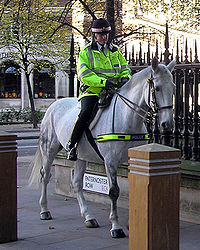
The Albish judicial system is entirely based on the common law and has as its Magna Carta the Common Charter, which was promulgated months after the Albish Spring in 1786. The Common Charter, despite being known as the national constitution, is one of the several laws, treaties and conventions that are used for setting the directives of the state, being part of the semi-codified Constitution of Albeinland. The highest national court is the High Court of Justice, which is both a court of last resort and constitutional court. Regions and counties are allowed to have their legislation and constitutions, but they must respect federal law.
Law enforcement is carried out by different entities and institutions, all of them within the Secretary of Home Affairs. The main law enforcement agency is the Albish Police Service, which acts as a preventive, detective and forensic police force. The APS is directly controlled by the Federal Government with the participation and assistance of regional and county governments. Other law enforcement agencies are the National Gendarmerie Force, which is used in cases of national unrests, protests and attacks, and the Metropolitan Police Service, which is the police force of Castelby and its metropolitan area. Most of the Albish police forces don't carry firearms, with only exclusive groups being allowed to use them.
According to national and international reportings, Albeinland has a homicide rate of 9.7 deaths per 100,000 inhabitants, considered to be within the recommended average of 10 deaths per 100,000 people. Capital punishment was abolished in 1962. State penitentiaries are also a responsibility of the home secretary under the Public Penintenciaries Service, being in average levels of occupation without any overcrowding issues.
The General Commonwealth Intelligence Service, also known by its abbreviation GCIS, is the national intelligence agency of Albeinland, being responsible for espionage and counter-espionage activities. Since its foundation at the height of the Melasian Crisis, the GCIS partnered with the DSA and Lavarian agencies under the BDTA against the Mageiros League and Perekovka Program in the Cold War, shifting its main focus to terrorist threats and drug trafficking in the 21st century.
Foreign policy

Albish foreign policy remained consistent over history, with its main focus being maintaining a balance of power among Berea while expanding its colonial holdings to other continents. The country was a member of almost every major war in the 18th, 19th and 20th centuries, standing against the Cuthish Empire on many occasions. Albeinland was one of the major combatants of the Great War and fought alongside Mascylla and Lavaria against the Kingsham Powers, establishing one of the major alliances of the world under the BDTA. During the Cold War, Albeinland clashed several times against the Mageiros League and the Perekovka Program, with hostilities reaching its height in the 60s.
Today, Albeinland is considered to be a regional and great power, still managing to heavily influence the international geopolitical scenario. The country has deep ties, both politically, economically and militarily, with former colonies, especially Sileria, through partnerships and alliances. Currently, Albeinland is a member of of the Assembly of Nations, the Berean Defence Treaty Association and the Albish-Silerian Council, among other international organizations.
Military

The Albish Armed Forces is one of the oldest institutions of Albeinland, established soon after its unification, and has as its commander-in-chief the lord-protector, but is subordinated to the Secretary of Defence and its secretary. Currently, the armed forces is divided into three branches: the Army, the Navy and the Air Force. According to own military data, around 55,000 personnel, including active and reservist officers, make up the current Albish forces, one of the smallest of Beria. Conscription was disbanded after the end of the Great War in 1916.
The Army is the smallest of all branches, being comprising only by a defence force due to Albeinland's small territory, numbers which have been decreasing since the end of the Melasian Crisis. Due to its size, Albeinland has prioritized more the use of commando units rather than conventional forces and, since the late-20th century, a series of mechanization programs have begun in order to make a more modernized military.
The Navy is the biggest and most respected branch, with its origins coming from the Albish League in the middle ages. Thanks to Albeinland's colonial empire and trade activities, the navy always has the flagship of the armed forces, being one of the biggest in the world. In modern times, the navy is considered to be a blue-water one, exercising military operations around the world with the help of other major powers. The majority of its ships are destroyers and corvettes, plus a substantial amount of aircraft carriers.
The air force is the most recent of all three branches, being created in 1919. It has about 350 manned aircraft in service, all of them in a relative state of modernization.
Albeinland is one of the few nations of the world that possesses nuclear weapons after a joint Albish-Mascyllary program in the 60s, resulting in the WH-1. With the ascension of worldwide terrorism, the armed forces shifted its main focus to its combat, partnering with other countries, especially BDTA members, against terrorist groups.






